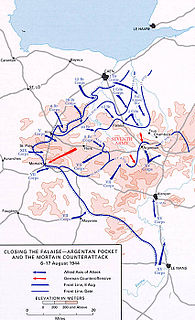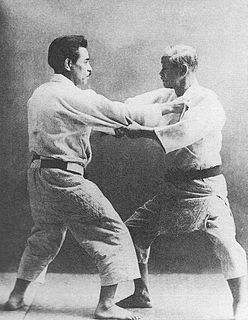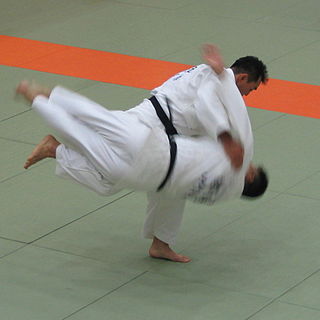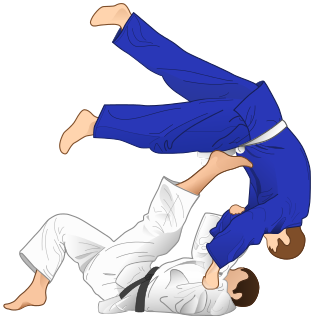
Nage-no-kata is one of the two Randori-no-kata of Kodokan Judo. It is intended as an illustration of the various concepts of nage-waza that exist in judo, and is used both as a training method and as a demonstration of understanding.
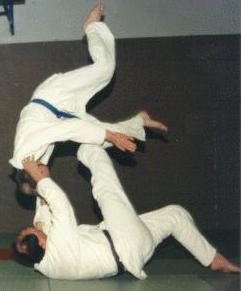
In martial arts, a throw is a grappling technique that involves off-balancing or lifting an opponent, and throwing them to the ground, in Japanese martial arts referred to as nage-waza, 投げ技, "throwing technique". Throws usually involve a rotating motion, the practitioner performing the throw disconnects with the opponent, and ends balanced and on their feet as opposed to a takedown where both finish on the ground. Throws can however also be followed into a top position, in which case the person executing the throw does not disengage from the opponent. Certain throwing techniques called sacrifice throws involve putting oneself in a potentially disadvantageous position, such as on the ground, in order to execute a throw.

Uki Goshi (浮腰) is one of the original 40 throws of Judo as developed by Jigoro Kano. It belongs to the first group, Dai Ikkyo, of the traditional throwing list, Gokyo, of Kodokan Judo. It is also part of the current 67 Throws of Kodokan Judo. It is classified as a hip technique, Koshi-Waza. Uki goshi is known as a favorite throw of Jigoro Kano himself. It is demonstrated in the Nage no Kata. It used to be much drilled in traditional judo dojos.

Ō goshi is one of the original 40 throws of Judo as compiled by Jigoro Kano.
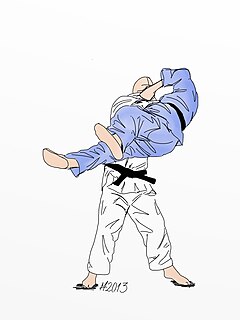
Ushiro Goshi (後腰), is one of the original 40 throws of Judo as developed by Jigoro Kano. It belongs to the fifth group, Gokyo, of the traditional throwing list, Gokyo-no-Nagewaza, of Kodokan Judo. It is also part of the current 67 Throws of Kodokan Judo.

Sumi Gaeshi (隅返) is one of the original 40 throws of Judo as developed by Jigoro Kano. It belongs to the fourth group,

Yoko Wakare (横分) is one of the original 40 throws of Judo as developed by Jigoro Kano. It belongs to the fifth group,

Yoko Guruma (横車), is one of the original 40 throws of judo as developed by Jigoro Kano. It belongs to the fifth group, Gokyo, of the traditional throwing list, Gokyo, of Kodokan Judo. It is also part of the current 67 throws of Kodokan Judo. It is classified as a side sacrifice technique, Yoko-sutemi. This technique is considerably difficult to perform, and can be used as either a direct attack or a counter. In classical study of nage-waza, it is preferable to use it as a counter throw to seoi-nage.

Osoto Otoshi (大外落) is one of the preserved throwing techniques, Habukareta Waza, of Judo. It belonged to the fourth group, Yonkyo, of the 1895 Gokyo no Waza lists. It is categorized as a foot technique, Ashi-waza.
Hikikomi Gaeshi (引込返), also known as pulling-in counter, is one of the preserved throwing techniques, Habukareta Waza, of judo. It belonged to the fourth group, Yonkyo, of the 1895 Gokyo no Waza lists. It is categorized as a front sacrifice technique, Ma-sutemi.
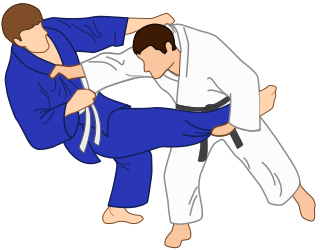
Kibisu gaeshi (踵返) is a single leg takedown or "Ankle Pick" adopted later by the Kodokan into their Shinmeisho No Waza list. It is categorized as a hand technique, Te-waza.
Practice of Kaeshi no Kata is almost entirely limited to Great-Britain, where until today it has been understood as a judo kata which, like the Gonosen-no-kata, focuses on counter-attacks to throwing techniques. The kata was commonly explained as being an older form than Gonosen-no-kata, that was passed onto Ōtani Masutarō from Tani Yukio.
The Nage-waza ura-no-kata is a judo kata that, like the Gonosen-no-kata, focuses on counter-attacks to throwing techniques. It was developed by Mifune Kyūzō, and is not an officially recognized Kodokan kata.
Tsubame Gaeshi (燕返し) is a Judo throw that falls within the seventeen techniques of the Shimmeisho no waza, officially recognised by the Kodokan in 1982. Literally translated as "Swallow Counter", Tsubame gaeshi is the countering of an ashi waza with Deashi harai from the opposite leg. A right-handed Deashi-harai executed by uke, for instance, would be avoided by tori bending his right knee, followed by a left-handed Deashi-harai. Tsubame gaeshi as a counter against uke's Deashi harai is the opening move of the Kaeshi-no-kata. As a counter against Okuriashi harai, it forms the sixth technique of the Nage-Waza-Ura-no-kata.
